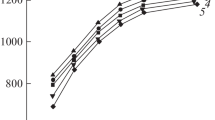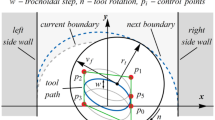Abstract
Although large-sized ceramic slabs have become a common market product nowadays, their finishing processes still lack proper analyses and optimizations. The finishing is carried out on energy-consuming polishing machines by a train of rotating abrasive heads, which oscillates in a transverse direction on translating slabs. In this paper, a computational method able to investigate the effect of the kinematics on the texture distribution is proposed. Its algorithms allow to map the number of contacts and the scratching angles, relevant factors in the definition of the polished surface quality, but also, differently from the previous studies, the easy use of any preferred law of motion. After validation, the method is applied to a traditional polishing machine in order to assess the optimal process parameters as the forward motion of the conveyor belt and the transverse oscillation of the beam carrying the rotating head with the fickerts. An enhancement in terms of surface quality and machining process is evident. In particular, results suggest to adopt a specific frequency value for the transverse motion, nearly the half of the original one: in spite of a very similar texture, a significant reduction of energy is permitted. Finally, the optimization of motions and processes may lead to other general benefits, such as a reduction of the tool wear and mitigation of possible issues as mechanical vibrations or noise.
Similar content being viewed by others
References
Raimondo M et al (2009) Innovative porcelain stoneware slabs (Lamina) from processing to applications, Proceedings of 11th International Conference on Advanced Materials, ICAM 2009, Rio de Janeiro (Brazil), September 20-25, 78–83
Gozzi A et al (2009) Technological behaviour of low-thickness ceramic tile. Ceram World Rev 83:78–82
Raimondo M et al (2010) Processing and properties of large-sized ceramic slabs. Bol Soc Esp Ceram V 49(4):289–296
Sánchez E, García-ten J, Sanz V, Moreno A (2010) Porcelain tile: almost 30 years of steady scientific-technological evolution. Ceram Int 36:831–845
Fragassa C (2015) Limits in application of international standards to innovative ceramic solutions. Int J Qual Res 9(2):279–298
Hutchings IM, Adachi K, Xu Y, Sánchez E, Ibáñez MJ, Quereda MF (2005) Analysis and laboratory simulation of an industrial polishing process for porcelain ceramic tiles. J Eur Ceram Soc 25:3151–3156
Rosa B et al (2014) Modeling and optimization of laser polishing process. Appl Mech Mater Trans Tech Publ:766–770
Pavlović A et al (2016) Modal analysis and stiffness optimization: the case of ceramic tile finishing. J Serbian Soc Comput Mech 10(2):30–44
Pavlović A, Minak G, Lucisano G, Sorcinelli F (2017) Harmonic analysis and dynamical response optimization in ceramic tile finishing. J Serbian Soc Comput Mech 11(2):27–39
Soltek – Comes teste satellitari (http://www.solteksrl.it/wp-content/uploads/2012/04/hts.pdf). Accessed 29 Mar 2019
Sousa FJP, Aurich JC, Weingaertner WL, Alarcon OE (2007) Analytical determination of the distribution of polishing time over the surface of polished tiles. J Am Ceram Soc 90(11):3468–3477
Sousa FJP, Alarcon OE, Weingärtner WL, Fredel MC, Vázquez MFQ, Vilches ES (2013) Evaluation of texture distribution during the industrial polishing process of porcelain stoneware tiles. J. Eur Ceram Soc 33:3369–3378
Sousa FJP, Hosse DS, Reichenbach I, Aurich JC, Seewig J (2013) Influence of kinematics and abrasive configuration on the grinding process of glass. J Mater Process Technol 213:728–739
Hutchings M et al (2006) Optimization of the polishing process for porcelain ceramic tiles. QUALICER
Sousa FJP, Aurich JC, do Nascimento RM, Paskocimas CA, Tartas D (2016) Experimental evaluation of on-line discrete tile rotations in the polishing process of ceramic tiles. CIRP J Manuf Sci Technol 14:1–9
Ahryman SB et al (2014) Distribution of contact pressure over the surface of ceramic floor tiles during the polishing process. J. Eur Ceram Soc 34:3209–3215
Sousa FJP et al (2010) Simulation and analysis of an alternative kinematics for improving the polishing uniformity over the surface of polished tiles. Boletin de la Sociedad Española de Ceramica y Vidrio 49:247–252
Tam Hy, Cheng H (2010) An investigation of the effects of the tool path on the removal of material in polishing. J Mater Process Technol 210:807–818
Soares Filho JE et al (2018) Estimation of the minimum material removal thickness during the polishing process of ceramic tiles by laser triangulation. Ceram Int 44:4646–4652
Sousa FJP, Aurich JC, Weingaertner WL, Alarcon OE (2009) Optimization of the kinematics available in the polishing process of ceramic tiles by computational simulations. J Am Ceram Soc 92(1):41–48
Lu na Abrasivi, web catalogue, (http://www.lunabrasivi.it/catalogue-masonry). Accessed 29 Mar 2019.
Acknowledgements
Realized with the support of the European Union and the Region Emilia-Romagna (POR-FESR 2014-2020, Axis 1, Research and Innovation) inside the “IPERCER” project with the aim of developing energy efficient solutions for the production of large porcelain stoneware tiles.
Author information
Authors and Affiliations
Corresponding author
Additional information
Publisher’s note
Springer Nature remains neutral with regard to jurisdictional claims in published maps and institutional affiliations.
Rights and permissions
About this article
Cite this article
Campione, I., Fragassa, C. & Martini, A. Kinematics optimization of the polishing process of large-sized ceramic slabs. Int J Adv Manuf Technol 103, 1325–1336 (2019). https://doi.org/10.1007/s00170-019-03623-3
Received:
Accepted:
Published:
Issue Date:
DOI: https://doi.org/10.1007/s00170-019-03623-3




